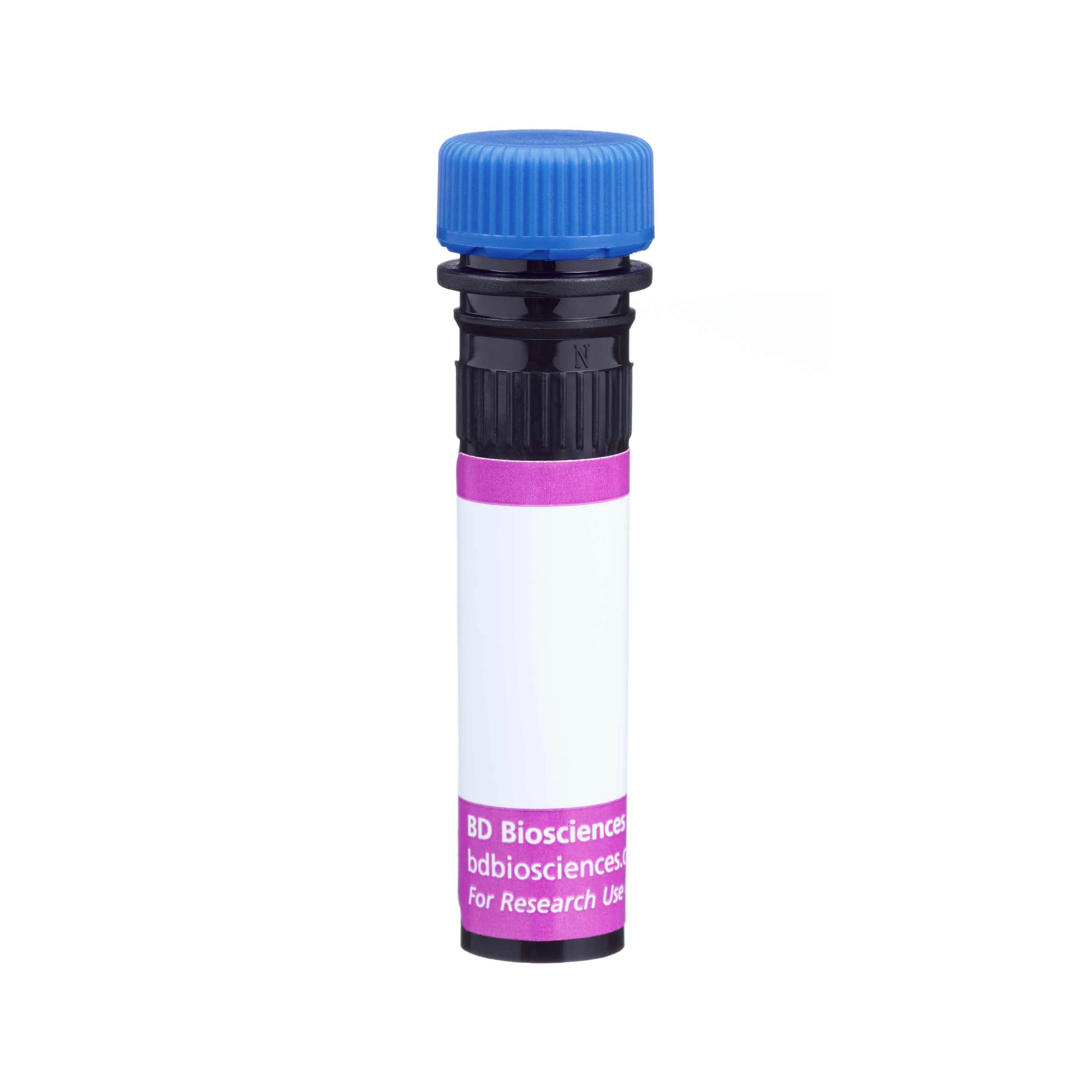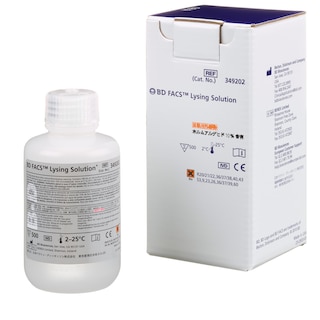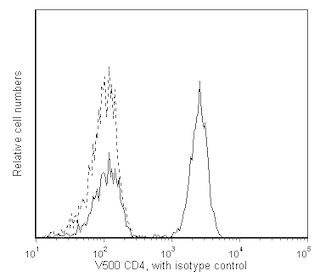-
Your selected country is
Middle East / Africa
- Change country/language
Old Browser
This page has been recently translated and is available in French now.
Looks like you're visiting us from {countryName}.
Would you like to stay on the current country site or be switched to your country?




Flow cytometric analysis of CD197 (CCR7) on human peripheral blood lymphocytes. Whole blood was stained with BD Horizon™ V450 Mouse Anti-Human CD197, BD Horizon™ V500 Mouse Anti-Human CD4 (clone RPA-T4, Cat. No. 560768) and APC-H7 Mouse Anti-Human CD45RA (clone HI100, Cat. No. 560674) antibodies. The erythrocytes were lysed with BD PharmLyse™ Lysing Buffer (Cat. No. 555899). A two-color flow cytometric dot plot showing the correlated expression patterns of CD45RA versus CD197 was derived from human CD4-positive T cell-gated events with the forward and side light-scatter characteristics of viable lymphocytes. Flow cytometry was performed using a BD LSR™ II flow cytometer system.


BD Pharmingen™ V450 Mouse anti-Human CD197 (CCR7)

Regulatory Status Legend
Any use of products other than the permitted use without the express written authorization of Becton, Dickinson and Company is strictly prohibited.
Preparation And Storage
Product Notices
- This reagent has been pre-diluted for use at the recommended Volume per Test. We typically use 1 × 10^6 cells in a 100-µl experimental sample (a test).
- Caution: Sodium azide yields highly toxic hydrazoic acid under acidic conditions. Dilute azide compounds in running water before discarding to avoid accumulation of potentially explosive deposits in plumbing.
- BD Horizon V450 has a maximum absorption of 406 nm and maximum emission of 450 nm. Before staining with this reagent, please confirm that your flow cytometer is capable of exciting the fluorochrome and discriminating the resulting fluorescence.
- For fluorochrome spectra and suitable instrument settings, please refer to our Multicolor Flow Cytometry web page at www.bdbiosciences.com/colors.
- Pacific Blue™ is a trademark of Molecular Probes, Inc., Eugene, OR.
- Please refer to www.bdbiosciences.com/us/s/resources for technical protocols.
Companion Products






The monoclonal antibody 150503 specifically binds to the human CC chemokine receptor, CCR7, also known as CD197. CCR7 (previously known as BLR2, EBI1 and CMKBR7), a seven-transmembrane, G-protein-coupled receptor, is the specific receptor for CC chemokines, MIP-3β/Exodus 3/ELC/ CCL19 and 6Ckine/Exodus 2/SLC/TCA4/CCL21. CCR7 mRNA is expressed mainly in lymphoid tissues including the spleen, lymph nodes and tonsil. CD197/CCR7 is expressed on peripheral T and B lymphocytes by bone marrow and cord blood CD34-positive cells and by mature dendritic cells. In response to its cognate chemokines, CD197/CCR7 mediates homing of leucocytes to secondary lymphoid tissues. Differential CCR7 expression can be used to distinguish naive, central memory, and effector memory T cell subsets. The human CCR7 gene, unlike other CC chemokine receptor genes, has been mapped to chromosome 17 (region 17q12).
The antibody is conjugated to BD Horizon™ V450, which has been developed for use in multicolor flow cytometry experiments and is available exclusively from BD Biosciences. It is excited by the Violet laser Ex max of 406 nm and has an Em Max at 450 nm. Conjugates with BD Horizon™ V450 can be used in place of Pacific Blue™ conjugates.
Caution: Under some complex multi-color conditions, this clone may non-specifically interact with antibodies conjugated with APC-H7 or APC-Cy7, contributing to staining artifacts. BD Horizon Brilliant Stain™ Buffer (Cat. No. 563794), designed to minimize on non-specific fluorescent dye interactions, does not resolve this interaction with either APC-H7 or APC-Cy7. For optimal multicolor staining results, alternatives to APC-H7 and APC-Cy7 should be evaluated.

Development References (10)
-
Birkenbach M, Josefsen K, Yalamanchili R, Lenoir G, Kieff E. Epstein-Barr virus-induced genes: first lymphocyte-specific G protein-coupled peptide receptors. Nature. 1993; 67(4):2209-2220. (Biology). View Reference
-
Burgstahler R, Kempkes B, Steube K, Lipp M. Expression of the chemokine receptor BLR2/EBI1 is specifically transactivated by Epstein-Barr virus nuclear antigen 2. Biochem Biophys Res Commun. 1995; 215(2):737-743. (Biology). View Reference
-
Kim CH, Pelus LM, White JR, Broxmeyer HE. Macrophage-inflammatory protein-3 beta/EBI1-ligand chemokine/CK beta-11, a CC chemokine, is a chemoattractant with a specificity for macrophage progenitors among myeloid progenitor cells. J Immunol. 1998; 161(5):2580-2585. (Biology). View Reference
-
Lipp M, Burgstahler R, Muller G, et al. Functional organization of secondary lymphoid organs by the chemokine system. Curr Top Microbiol Immunol. 2000; 251:173-179. (Biology). View Reference
-
Sallusto F, Lenig D, Forster R, Lipp M, Lanzavecchia A. Two subsets of memory T lymphocytes with distinct homing potentials and effector functions. Nature. 1999; 401(6754):708-712. (Biology). View Reference
-
Schweickart VL, Raport CJ, Godiska R, et al. Cloning of human and mouse EBI1, a lymphoid-specific G-protein-coupled receptor encoded on human chromosome 17q12-q21.2. Genomics. 1994; 23(3):643-650. (Biology). View Reference
-
Yanagihara S, Komura E, Nagafune J, Watarai H, Yamaguchi Y. EBI1/CCR7 is a new member of dendritic cell chemokine receptor that is up-regulated upon maturation. J Immunol. 1998; 161(6):3096-3102. (Biology). View Reference
-
Yoshida R, Imai T, Hieshima K, et al. Molecular cloning of a novel human CC chemokine EBI1-ligand chemokine that is a specific functional ligand for EBI1, CCR7. J Biol Chem. 1997; 272(21):13803-13809. (Biology). View Reference
-
Yoshida R, Nagira M, Imai T, et al. EBI1-ligand chemokine (ELC) attracts a broad spectrum of lymphocytes: activated T cells strongly up-regulate CCR7 and efficiently migrate toward ELC. Int Immunol. 1998; 10(7):901-910. (Biology). View Reference
-
Yoshida R, Nagira M, Kitaura M, Imagawa N, Imai T, Yoshie O. Secondary lymphoid-tissue chemokine is a functional ligand for the CC chemokine receptor CCR7. J Biol Chem. 1998; 273(12):7118-7122. (Biology). View Reference
Please refer to Support Documents for Quality Certificates
Global - Refer to manufacturer's instructions for use and related User Manuals and Technical data sheets before using this products as described
Comparisons, where applicable, are made against older BD Technology, manual methods or are general performance claims. Comparisons are not made against non-BD technologies, unless otherwise noted.
For Research Use Only. Not for use in diagnostic or therapeutic procedures.
Report a Site Issue
This form is intended to help us improve our website experience. For other support, please visit our Contact Us page.